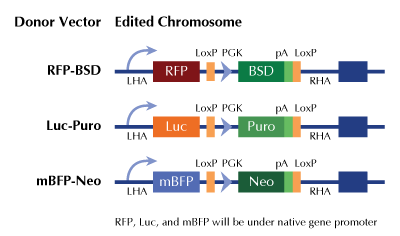FGFR3 Human Gene Knockout Kit (CRISPR)
CAT#: KN215533LP
FGFR3 - human gene knockout kit via CRISPR, HDR mediated
HDR-mediated knockout kit validation
CNY 12,260.00
CNY 3,710.00
CNY 1,999.00
CNY 2,700.00
CNY 8,856.00
Specifications
| Product Data | |
| Format | 2 gRNA vectors, 1 Luciferase-Puro donor, 1 scramble control |
| Donor DNA | Luciferase-Puro |
| Symbol | FGFR3 |
| Locus ID | 2261 |
| Kit Components |
KN215533G1, FGFR3 gRNA vector 1 in pCas-Guide CRISPR vector KN215533G2, FGFR3 gRNA vector 2 in pCas-Guide CRISPR vector KN215533LP-D, donor DNA containing left and right homologous arms and Luciferase-Puro functional cassette. GE100003, scramble sequence in pCas-Guide vector |
| Disclaimer | These products are manufactured and supplied by OriGene under license from ERS. The kit is designed based on the best knowledge of CRISPR technology. The system has been functionally validated for knocking-in the cassette downstream the native promoter. The efficiency of the knock-out varies due to the nature of the biology and the complexity of the experimental process. |
| Reference Data | |
| RefSeq | NM_000142, NM_001163213, NM_022965, NM_001354809, NM_001354810, NR_148971 |
| Synonyms | ACH; CD333; CEK2; HSFGFR3EX; JTK4 |
| Summary | This gene encodes a member of the fibroblast growth factor receptor (FGFR) family, with its amino acid sequence being highly conserved between members and among divergent species. FGFR family members differ from one another in their ligand affinities and tissue distribution. A full-length representative protein would consist of an extracellular region, composed of three immunoglobulin-like domains, a single hydrophobic membrane-spanning segment and a cytoplasmic tyrosine kinase domain. The extracellular portion of the protein interacts with fibroblast growth factors, setting in motion a cascade of downstream signals, ultimately influencing mitogenesis and differentiation. This particular family member binds acidic and basic fibroblast growth hormone and plays a role in bone development and maintenance. Mutations in this gene lead to craniosynostosis and multiple types of skeletal dysplasia. [provided by RefSeq, Aug 2017] |
Documents
| Product Manuals |
| FAQs |
Resources
| 基因表达相关资源 |
Other Versions
| SKU | Description | Size | Price |
|---|---|---|---|
| KN215533 | FGFR3 - human gene knockout kit via CRISPR, HDR mediated |
CNY 12,260.00 |
|
| KN215533BN | FGFR3 - human gene knockout kit via CRISPR, HDR mediated |
CNY 12,260.00 |
|
| KN215533RB | FGFR3 - human gene knockout kit via CRISPR, HDR mediated |
CNY 12,260.00 |
|
| KN415533 | FGFR3 - KN2.0, Human gene knockout kit via CRISPR, non-homology mediated. |
CNY 8,680.00 |
|
| GA101584 | FGFR3 CRISPRa kit - CRISPR gene activation of human fibroblast growth factor receptor 3 |
CNY 12,255.00 |


 United States
United States
 Germany
Germany
 Japan
Japan
 United Kingdom
United Kingdom
 China
China

